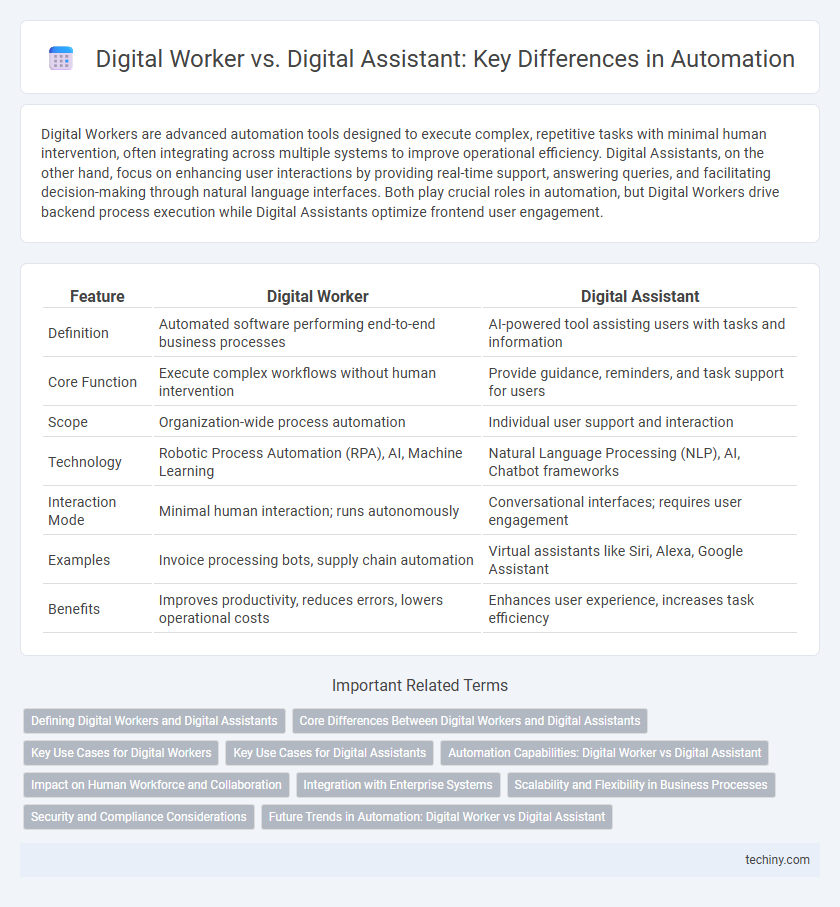Digital Workers are advanced automation tools designed to execute complex, repetitive tasks with minimal human intervention, often integrating across multiple systems to improve operational efficiency. Digital Assistants, on the other hand, focus on enhancing user interactions by providing real-time support, answering queries, and facilitating decision-making through natural language interfaces. Both play crucial roles in automation, but Digital Workers drive backend process execution while Digital Assistants optimize frontend user engagement.
Table of Comparison
| Feature | Digital Worker | Digital Assistant |
|---|---|---|
| Definition | Automated software performing end-to-end business processes | AI-powered tool assisting users with tasks and information |
| Core Function | Execute complex workflows without human intervention | Provide guidance, reminders, and task support for users |
| Scope | Organization-wide process automation | Individual user support and interaction |
| Technology | Robotic Process Automation (RPA), AI, Machine Learning | Natural Language Processing (NLP), AI, Chatbot frameworks |
| Interaction Mode | Minimal human interaction; runs autonomously | Conversational interfaces; requires user engagement |
| Examples | Invoice processing bots, supply chain automation | Virtual assistants like Siri, Alexa, Google Assistant |
| Benefits | Improves productivity, reduces errors, lowers operational costs | Enhances user experience, increases task efficiency |
Defining Digital Workers and Digital Assistants
Digital Workers are AI-driven software programs designed to execute repetitive, rule-based tasks autonomously, enhancing operational efficiency across various business functions. Digital Assistants leverage natural language processing and machine learning to interact with users, providing personalized support and facilitating complex decision-making through conversational interfaces. Both technologies serve distinct roles in automation, with Digital Workers focusing on task automation and Digital Assistants emphasizing user engagement and assistance.
Core Differences Between Digital Workers and Digital Assistants
Digital Workers automate complex business processes using AI and machine learning, enabling end-to-end task execution without human intervention. Digital Assistants primarily focus on enhancing user experience by providing interactive support through natural language understanding and speech recognition. Core differences lie in operational scope and autonomy, with Digital Workers handling back-office workflows and Digital Assistants facilitating front-office communication.
Key Use Cases for Digital Workers
Digital Workers excel in automating complex, repetitive business processes such as invoice processing, customer onboarding, and compliance reporting, significantly reducing operational costs while enhancing accuracy. These software robots operate autonomously across multiple platforms, integrating seamlessly with enterprise systems like ERP, CRM, and HRMS to streamline workflows. Unlike Digital Assistants that focus on user interaction, Digital Workers deliver high-value backend automation in finance, supply chain management, and human resources to optimize productivity and scalability.
Key Use Cases for Digital Assistants
Digital Assistants excel in customer service automation, handling inquiries through natural language processing and providing real-time support across multiple channels. They streamline scheduling, reminders, and task management for improved personal and organizational productivity. Use cases also include IT helpdesk support, enabling quick resolution of common technical issues without human intervention.
Automation Capabilities: Digital Worker vs Digital Assistant
Digital Workers possess advanced automation capabilities, handling complex, multi-step business processes with cognitive skills such as decision-making, natural language understanding, and data analysis. Digital Assistants mainly support users through task automation and simple interactions, streamlining repetitive activities like scheduling, reminders, and basic information retrieval. The automation strength of Digital Workers lies in end-to-end process execution and integration across systems, whereas Digital Assistants enhance productivity through user-centric, conversational automation.
Impact on Human Workforce and Collaboration
Digital Workers automate repetitive tasks and processes, significantly enhancing operational efficiency and reducing human error in the workforce. Digital Assistants support employees by providing real-time information and managing workflows, enabling improved collaboration and decision-making. Together, they transform workplace dynamics by optimizing human labor and fostering seamless interaction between humans and technology.
Integration with Enterprise Systems
Digital Workers offer deeper integration with enterprise systems by leveraging APIs and robotic process automation (RPA) to execute complex, end-to-end workflows across multiple platforms. Digital Assistants primarily provide user-facing interfaces that facilitate tasks through natural language processing but rely on existing enterprise integrations to access data. The seamless interaction of Digital Workers with ERP, CRM, and SCM systems ensures enhanced operational efficiency and data consistency across the organization.
Scalability and Flexibility in Business Processes
Digital Workers offer enhanced scalability by autonomously managing complex, repetitive tasks across multiple systems, allowing businesses to rapidly adapt to workload fluctuations. Digital Assistants provide flexibility by supporting human interactions and decision-making through natural language processing and context-aware responses, enabling seamless collaboration within diverse workflows. Integrating Digital Workers and Digital Assistants optimizes business processes by combining automated scalability with adaptive flexibility, ensuring efficient and responsive operational management.
Security and Compliance Considerations
Digital Workers operate with advanced automation capabilities, often handling sensitive data and complex workflows, thus requiring robust security frameworks and strict compliance adherence to regulations like GDPR and HIPAA. Digital Assistants typically manage user interactions and simpler tasks but still necessitate encryption, identity verification, and regular audits to mitigate risks and ensure data privacy. Implementing role-based access controls and continuous monitoring is critical for both to maintain secure environments and meet industry compliance standards.
Future Trends in Automation: Digital Worker vs Digital Assistant
Future trends in automation emphasize the expanding role of digital workers, which are designed to perform complex, end-to-end tasks autonomously across business processes, contrasting with digital assistants that primarily provide user support and interaction through natural language interfaces. Digital workers leverage artificial intelligence, machine learning, and robotic process automation (RPA) to drive operational efficiency and decision-making without human intervention. The shift toward intelligent automation will increasingly blur the lines between digital workers and assistants, enabling seamless collaboration between humans and machines for enhanced productivity and innovation.
Digital Worker vs Digital Assistant Infographic

 techiny.com
techiny.com